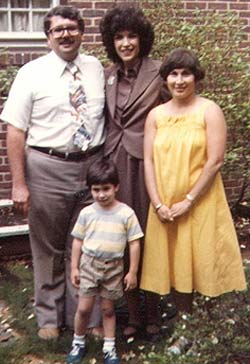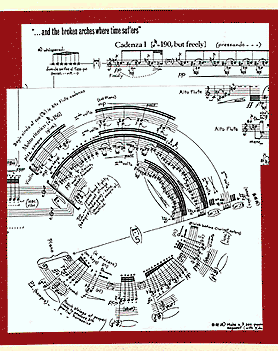|
|
|
Part 3 of 3
 |
With her busy schedule, Norma herself can't practice every day, but she was deep in practicing the day of this
interview. Power bar breakfast During the weekend telephone interview, we heard her oven timer ring in the background. Norma was also in the midst of baking the special power bars she likes to eat when there's no time for a conventional breakfast between her morning exercise routine and rehearsal. "They're much lower in fat than anything you can buy," she said. Bakes special muffins Norma's culinary prowess also includes baking oatmeal muffins beefed up with |
![]()
|
Above left: Since the photo was taken in 1978, Norma has undergone a physical transformation and has long maintained her trim new shape as well as her stamina. She attributes this success to a combination of her workout program, sports involvements, and the Zone program of eating. Alex was four years old when the Rogers of Nashville were visited by Bruce's first cousin, Susan Rogers, erstwhile flutist and CousinsPlus webmaster and editor-in-chief. |
![]()
| protein powder. Two of either the muffins or
the power bars, supplemented with an apple, and a handful of almonds during the orchestra
rehearsal break about 11:30 a.m., keep her going full tilt until lunchtime at 1 p.m. She
will gladly supply her recipes to anyone who asks. Exercise for stamina By 7:30 a.m. most weekday mornings, Norma is in the Fitness Center at the Jewish Community Center where she works out on the treadmill, Stairmaster and Cybex weight machines for three-quarters of an hour. On Sundays, there's her doubles tennis group. "Exercise keeps my energy up," she said. The Zone program is based on maintaining a certain balance of the food groups. Barry Sears' book, "The Zone," published by Harper Collins in 1995, set forth the program, and the book long occupied a prominent position on bestseller lists. |
![]()
Contemporary challenges In addition to preparing for a symphony performance two weeks away of a Ravel piano concerto "with a big piccolo solo at the beginning," Norma was also facing the challenges of contemporary works by composers en route to Tennessee for visits as composers in residence. The most daunting is a work for unaccompanied flute by Donald Martino, who is currently teaching composition at Harvard. On arrival six months hence for his stint as composer in residence, he would be expecting to hear Norma play "Quodlibets II" for unaccompanied flute. Learns 3 new notes Martino's composition is "all over the place," said Norma, who had to add three notes to her repertoire four octaves above middle C on the piano. "The piece goes up to high F, so I had to learn the three notes between high D and F to get up there," she said. In addition, there are the composer's unusual markings. "You have to learn the directions" in the legend that corresponds to all the strange markings, she said. |
As challenging as it gets: The composition above for unaccompanied flute by Donald Martino requires frequent huge interval jumps and several notes above the instrument's normal range. |
![]()
| Extremely difficult "There are slashes to indicate whether a note should sound like an upbeat or a downbeat, and markings for different kinds of breath -- a normal breath or a longer breath -- and how fast the grace notes should be played. There's flutter tongue mixed in, and immediate changes in dynamics, and the piece goes at a good clip," she said. "It's extremely difficult." Flutter tongue Flutter tongue is the technique of flipping the front of your tongue against the roof of your mouth, as in the Spanish sound of "rr." When done on the flute, it gives a special effect. "It creates a blurred sound on the note," Norma explained. |
![]()
 |
Full of surprises Norma was also preparing, for a composer in residence expected soon,
a more conventional work scored for a chamber group of viola, harp and flute. However,
more often than not, the composer in residence is a source of surprises, as was George
Crumb, who wrote his composition scored for violin, clarinet, piano and alto flute in the
form of circles. "He did it to make the music more interesting to look at for the
musicians," Norma said. "You just have to get used to it, and then it's not
difficult to follow. It looks harder than it is." |
![]()
| Just say no For the performance of "Thirteen Ways of Looking at a Blackbird," scored for voice, percussion, piano and flute, visiting composer Lucas Foss asked Norma to play her part perched on the platform with the organ pipes near the ceiling above the concert stage. Norma declined, saying it was not practical. "Performance of this composition required eye contact among the musicians," she said. No practice, no lessons Norma began playing flute in the fourth grade, but in the sixth grade she became more interested in sports than in music. "I was on the track team and the volleyball team," she said. When she stopped practicing, her parents stopped the lessons, but she did continue playing in the school orchestra. Then she began to miss studying flute. "I wasn't feeling good about my playing," she recalled, so she decided it would be a good idea to change teachers. |
![]()
The great Kincaid In the seventh grade, she began studying with the "very inspiring" John Krell of the Philadelphia Orchestra. After six years, he said, "It's time for you to move on, and have the experience of studying with Kincaid." ( William Kincaid was one of the most famous and highly regarded flutists of this century.) In the eighth grade, Norma not only won first chair in All-City Band, but the conductor did a band arrangement for strings and flute of the Italian Air from Telemann's Suite in A Minor especially for her. |
|
| Norma played third chair flute in Philadelphia's 1959 All-City Band (see above) and the following year, first chair. |
|
![]()
| Accepted by Juilliard When it came time for college, Norma considered Juilliard where she would have studied with another great flutist, the legendary Julius Baker, principal flutist of the New York Philharmonic. She was accepted, but because Juilliard did not then have student dormitories, she settled on Temple University in her hometown of Philadelphia. Another new teacher She was thus able to continue studying with Kincaid, principal flutist of the Philadelphia Orchestra, whose playing she described as "exquisite." After studying with him for two years, he became ill and retired. His chair was taken by James Pellerite, who would eventually became Norma's teacher. Marching band? No! When Pellerite decided to move to Indiana University to
take up a teaching position at its prestigious School of Music, Norma transferred there.
But that was only one of her two reasons for the change. It happened that Temple
University required all woodwind enrollees to participate in |
![]()
|
comply. "I had a big argument with the dean," she said. "I told him to just give me an F in band. It was a waste of time 'period!' to play in the band, not just in traveling to games." A musical friendship at left:
"We were in band |
![]()
| Huge music program Indiana University turned out to be a wonderful place for a musician. "There are 3,500 students in the School of Music, and they have five full orchestras and some of the best programs in the country," Norma said. Part of the voice department is presentation of "an opera every week throughout the school year and the summer," she said. "It's probably the longest opera season in the country." |
![]()
Plays for mother-in-law Norma's mother-in-law, Ruth Rogers, recalled in a recent telephone conversation from her home in Florida the first time she heard Norma play. "After she and Bruce were engaged, she brought her flute to the Bronx on a visit to see us," Ruth said. "I remember Arthur had just come home from the hospital after one of his heart attacks. Her playing was just beautiful." Does Bruce recall the first time he heard his wife play solo? "It was at a recital," he said. "By that time, I was already in love with her." Right: Just 11 months after meeting at Hillel, Bruce and Norma danced at their wedding. |
|
Copyrightę Susan M. Rogers 2002 |